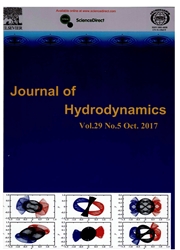

 中文摘要:
中文摘要:
Previous experimental and numerical analyses of the pressure pulse characteristics in a Francis turbine are extended here by using the unsteady Reynolds-averaged Navier-Stokes equations with the shear stress transport(SST) turbulence model to model the unsteady flow within the entire flow passage of a large Francis pump turbine with misaligned guide vanes at the rated rotational speed. The S-curve characteristics are analyzed by a combined use of the model test and the steady state simulation with the aligned guide vane firstly. Four misaligned guide vanes with two different openings are chosen to analyze the influence of pressure pulses in the turbine. The characteristics of the dominant unsteady flow frequencies in different parts of the pump turbine for various misaligned guide vane openings are investigated in detail. The predicted hydraulic performance and the pressure fluctuations show that the misaligned guide vanes reduce the relative pressure fluctuation amplitudes in the stationary part of the flow passage, but not the runner blades. The misaligned guide vanes have changed the low frequencies in the entire flow passage with the change of the pulse amplitudes mainly due to changes in the rotor-stator interaction and the low frequency vortex rope flow behavior.
 英文摘要:
英文摘要:
Previous experimental and numerical analyses of the pressure pulse characteristics in a Francis turbine are extended here by using the unsteady Reynolds-averaged Navier-Stokes equations with the shear stress transport (SST) turbulence model to model the unsteady flow within the entire flow passage of a large Francis pump turbine with misaligned guide vanes at the rated rotational speed. The S-curve characteristics are analyzed by a combined use of the model test and the steady state simulation with the aligned guide vane firstly. Four misaligned guide vanes with two different openings are chosen to analyze the influence of pressure pulses in the turbine. The characteristics of the dominant unsteady flow frequencies in different parts of the pump turbine for various misaligned guide vane openings are investigated in detail. The predicted hydraulic performance and the pressure fluctuations show that the misaligned guide vanes reduce the relative pressure fluctuation amplitudes in the stationary part of the flow passage, but not the runner blades. The misaligned guide vanes have changed the low frequencies in the entire flow passage with the change of the pulse amplitudes mainly due to changes in the rotor-stator interaction and the low frequency vortex rope flow behavior.
 同期刊论文项目
同期刊论文项目
 同项目期刊论文
同项目期刊论文
 期刊信息
期刊信息
